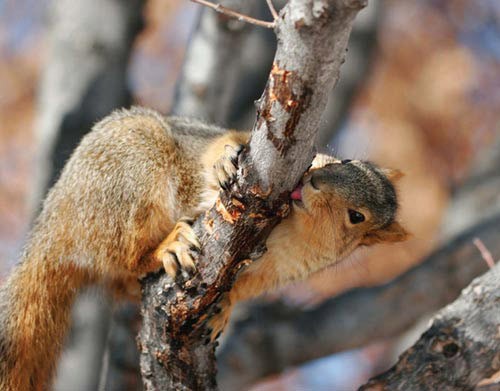The transition from late winter to early spring is my favorite time for wildlife photography. The warming snow pack is pock-marked with tracks everywhere; some creatures are seeking mates, some are preparing for new offspring, and others are enjoying new sources of nourishment.
I often get busted at this time, too. A busy-body red squirrel invariably discovers me, hidden quietly in my blind, and scolds me with much foot stomping, tail flagging, and churring. There’s little merit in getting up and relocating, however. Usually, the territorial sciurid eventually quits and goes about other business. On one occasion many years ago, I was fascinated to watch a red squirrel travel along the smooth trunk and limbs of a nearby young red maple, periodically stopping to cock its head and bite through the bark into the xylem. Hours later, after the sap had leaked through the wounds and then freeze-dried in the chilling evening air, the same squirrel returned and licked at the site of the wound’s now-concentrated nutrients.
Maple sap is also being harvested by us at this time, so I naturally deduced that the scores upon scores of squirrel-made “sap taps,” as I have named them, might actually serve the same purpose. Sure enough, Bernd Heinrich, respected biologist and well-known author, made a similar observation and systematically sought to prove it. Heinrich concluded that the large temperature fluctuations that occur in late fall, during warm spells in winter, and especially in early spring, create an opportunity for squirrels to tap trees for their sugar – especially sugar maple. He observed many squirrels returning to their sap holes to lick the “candied sugar streaks” after the sap’s watery contents had evaporated. Heinrich meticulously proved that the dried wounds’ exudate had a sugar content considerably higher than that of the original sap.
While sugar maple is the tree of choice, I’ve discovered red and gray squirrel taps on 23 species of trees and shrubs, including all maple species, bitternut hickory, red oak, apple, aspen, basswood, witch hazel, and rhododendron, to name just a few of the curious varieties involved. A stem or branch simply has to be smooth and thin-barked, and thus easily wounded. Sugars, as Heinrich proposes, are a sought after nutrient, but I suspect minerals may also be key attractants.
Careful inspection of the sap taps shows the dot-dash pattern I’ve described for black bear scent-marking bites. The dot is a smaller wound created by the squirrel’s upper incisors, which were inserted into the bark and anchored there, while the longer dash is caused by the movement of the lower jaw’s incisors scraping across the bark. Squirrel tap marks measure roughly two millimeters wide for two incisors side by side. It’s fun to examine fresh sap taps in early spring, for you can readily see the minute grooves that were created by the squirrel’s teeth.
Some small maples become covered with hundreds of the tiny calloused scars resulting from the accumulation of sap tap wounds over years of time. Occasionally, sugar maples in particular may become black with the opportunistic growth of a sooty mold organism, an Ascomycete fungus that is able to subsist on sweet nutrients released from the tree’s wounds.


